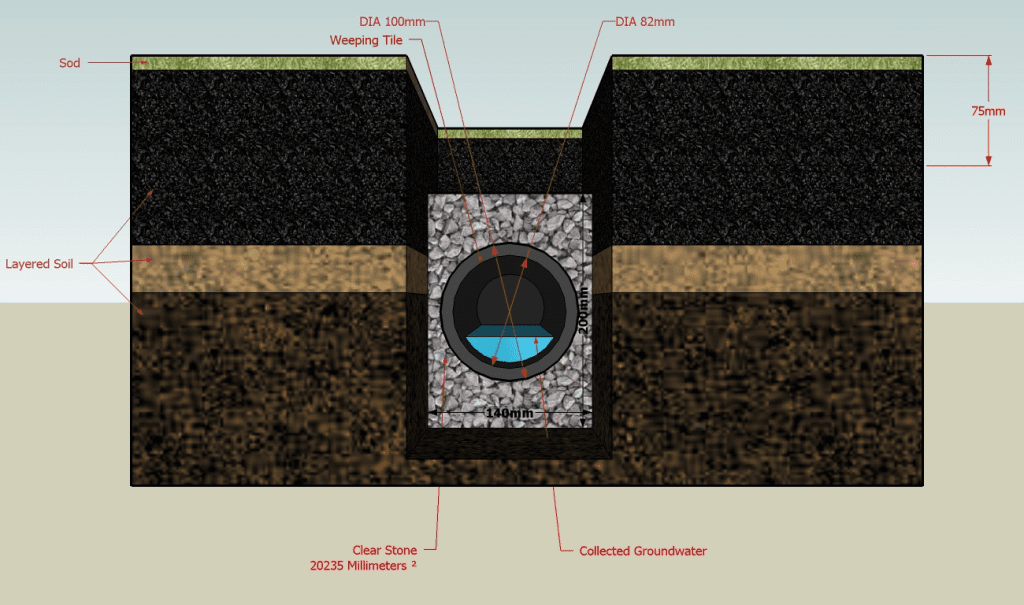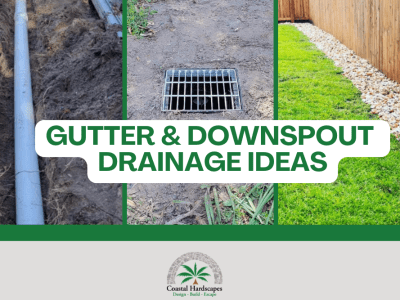Are you looking for effective gutter drainage solutions for your home or business?
Whether you live in the Coastal Savannah, GA area or elsewhere, heavy storms produce large quantities of water. Your downspouts are responsible for dispersing the water collected by your gutters, but they don’t always do so correctly.
If you don’t have the proper gutter drainage solution, downspouts can cause erosion or water runoff around your foundation. Today, we will share the most effective ways to mitigate downspout issues and reuse your rainwater with these gutter drainage tips!
9 Gutter Drainage Solutions for Gutters
Here is our list of the best gutter/downspout drainage tips to help you with run-off water!
1. Add underground drainage solutions.
Installing an underground drainage system is the best way to utilize and disperse rainwater effectively. Completing this type of project is labor intensive and will take the most time, however, it is the BEST and most long-term option. To properly install your drainage underground, you will need to ensure you follow these steps:
- Mark utilities before ever digging
- Map out the downspouts, run-off areas, and location of the drainage emitter(s)
- Pick between PVC (lasts longer) or corrugated pipe, get all other necessary materials
- Dig a trench stretching 6 inches across and 8-12 inches deep. To add a grade, 1/4 inch per foot encourages the proper downward slope.
- If you use corrugated pipe, install a base of gravel.
- Lay your pipe in the trench and connect to turns, gutter downspouts, and emitters.
- Cover and pack with dirt gently, replacing sod as necessary.
As you can see, the longer your trench, the more digging it requires which is why hiring a professional can be your best bet. Look at the recent photos of an underground drainage system we installed with over 75 linear feet of piping on Tybee Island, GA:
Step 1: Dig Trench Accounting for Grade (1/4 inch per foot)

Step 2: Lay the PVC pipe in the trench

Step 3: Connect pipes underground

Step 4: Cover the pipe and area, & Gently pack dirt

2. Use a rain barrel

Don’t have time to dig a trench, but want to use the run off water for your garden or lawn anyway? One tip is installing a rain barrel that collects water from your downspout during storms. You can then use the water with a hose to repurpose on plants, the lawn, or for other uses.
➡️Tractor Supply 50 Gallon Rain Barrel
3. Install river rock to create a drainage system

River rock beds are a great way to repurpose rain water and create natural drainage solutions for downspouts and gutters. This homeowner in Pooler, GA, had a constant battle with but along their fence due to the downspouts and the neighbor’s run-off water all traveling to the same area.
With little sun exposure, we could use a partial underground/above-ground system. We placed corrugated pipe from the downspout to the fence. From there, we installed a weed barrier, followed by river rock.
4. Install a French Drain

Installing a French drain is the most complex solution, requiring quite a bit of earthwork and digging. Typically, a French drain is utilized for larger areas in residential neighborhoods or where excavation is occurring but proper water drainage is needed.
A French drain is an underground gutter drainage system consisting of layers of piping, gravel, and soil. The idea is that the ground absorbs the water and the underground drain moves water away from a specific location. Like we stated, this is the most complex and rigorous solution but works well with yards that have extreme drainage issues.
5. Fill low spots and fix the yard slope
Sometimes your downspouts aren’t the issue, instead it is uneven grading and low spots in your yard. If you notice pooling and water collecting close to your house around the downspouts, it could mean you need to address the low spots. Filling in the area with top soil can encourage proper drainage.
Gutter Care:
These last four tips will help you with drainage problems because they ensure your gutters are working correctly. Damaged or improper gutters can cause numerous issues.
6. Be sure to clean & inspect your gutters
Keeping your gutters clean might seem like an interesting tip. However, without clean gutters, you can see erosion issues and flooding. Gutters that don’t function properly can lead to countless problems, and the number one reason for gutter issues is clogging. Over time, clogged gutters can cause problems like sagging, water spillage, etc. Be sure to clean your gutters annually, and if you live near pine trees (common in the Southeast), inspect them regularly.
7. Install gutter guards
Gutter guards are a great solution if you don’t want to clean your gutters every fall. While there are many types of gutter guards, the best protection shouldn’t require cleaning. Be sure to stay away from cheap gutter screens, which can cause more issues than they help. Gutter guards clear your gutters, leading to proper drainage during storms.
8. Always have splash blocks

Splash blocks are a must if you don’t have a gutter drainage solution or river rocks at the base of your downspouts. While the water from your downspouts might not appear strong, it can cause soil, pavement, and even concrete erosion over time! Be sure always to have splash blocks at the end of your downspout.
9. Extend your downspouts

The simple and cheap solution to gutter downspout drainage issues is to extend the downspout, which allows you to direct the water flow. While it is not as aesthetically pleasing, you can install gutter downspout extenders for as little as $5 when you purchase them at your local hardware store.
Frequently Asked Questions:
1. Can standing water from my gutters damage my foundation?
Yes, standing water in gutters can cause significant damage to your foundation. When gutters overflow or remain clogged, water is redirected toward the base of your home, leading to soil erosion, increased moisture around the foundation, and potential cracks. Over time, this moisture can weaken the foundation, leading to structural issues such as settling or shifting.
2. How can I divert water from my gutter drainage system?
You can divert water by installing downspout extensions or an underground drainage system. Extensions move the water away from the foundation, while a French drain or a perforated pipe system can direct the water to a safe area, such as a dry well or storm drain, reducing the risk of foundation damage.
3. What are the best underground drainage pipes?
Typically, the best underground drainage pipes are PVC (see #1 above), corrugated polyethylene, or ADS (Advanced Drainage Systems) pipes. PVC pipes are durable and resistant to tree roots, while corrugated pipes are flexible and easier to install. ADS pipes are also highly durable and commonly used in residential drainage systems due to their strength and long lifespan.
4. How hard is it to install an underground gutter drainage system?
Installing an underground gutter drainage system is challenging and requires digging and some technical skill. You need to plan the layout, dig trenches, lay the pipe at a slope, and connect it to your downspouts. While a DIYer with basic plumbing knowledge can handle it, professional landscaping help may be needed for more complex installations or to ensure proper water flow.


 4 Landscape Lighting Ideas for Your Front and Backyard
4 Landscape Lighting Ideas for Your Front and Backyard
Leave a Reply